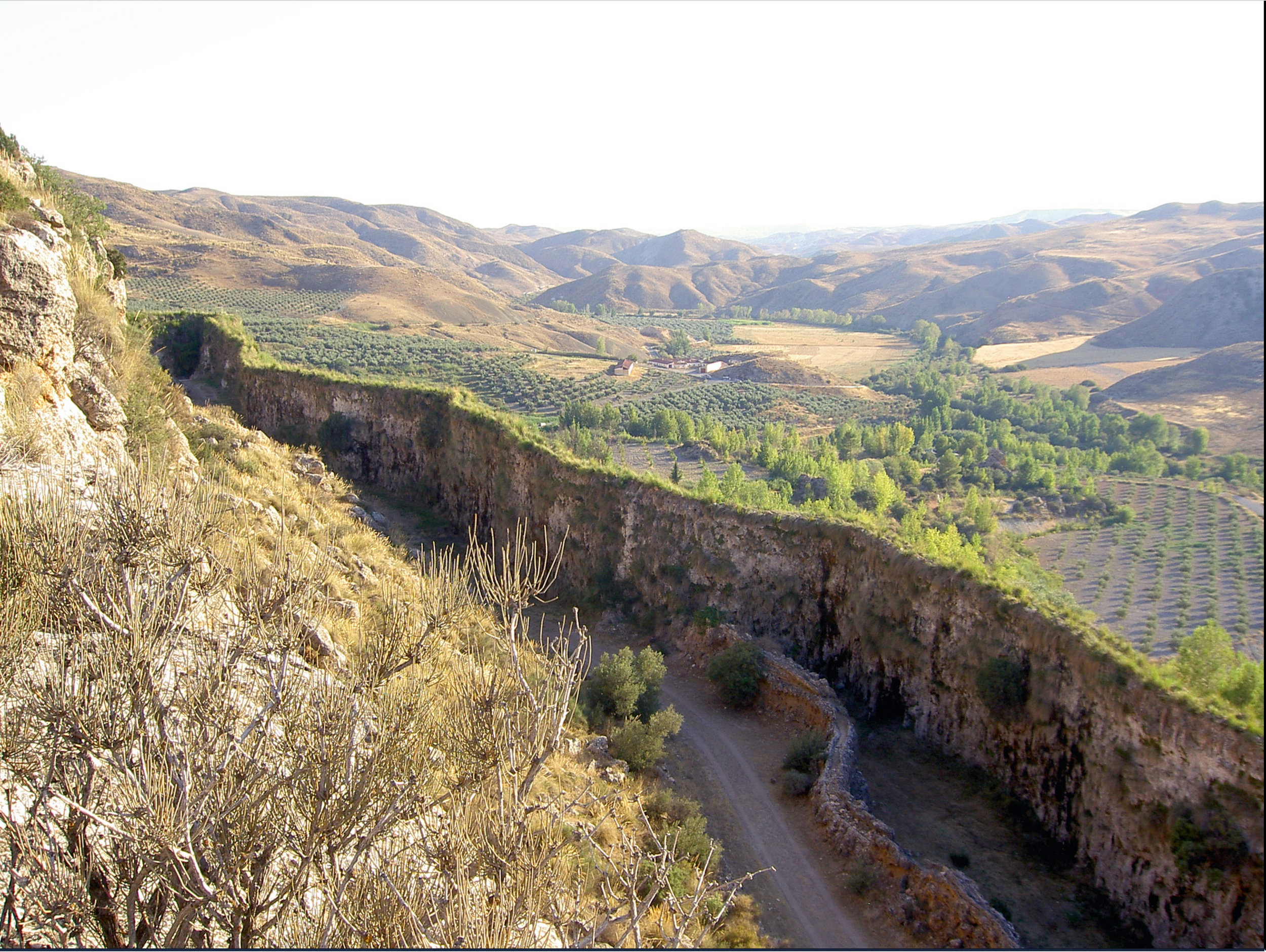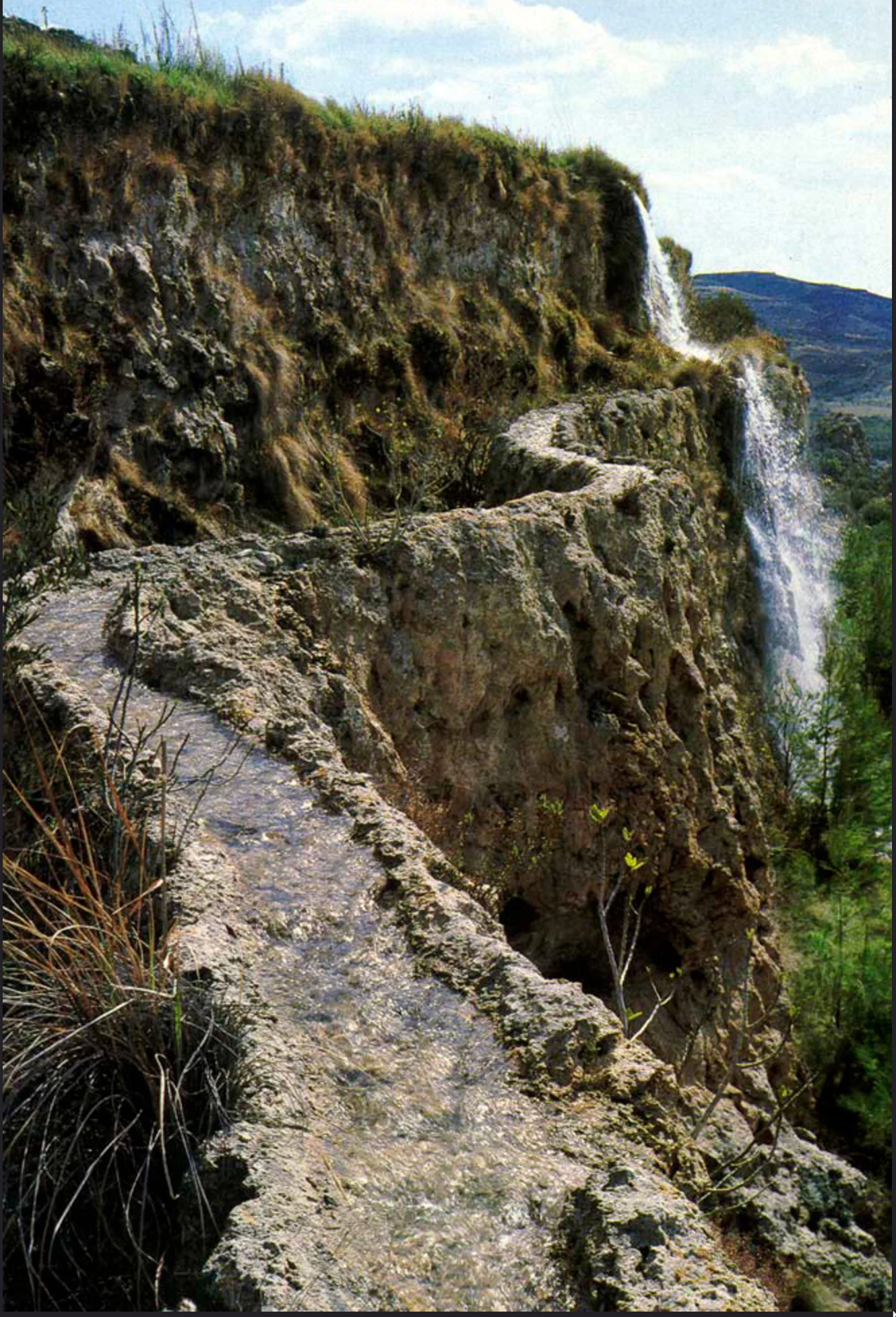The Mysterious Living Aqueduct in Spain
by Elyn Aviva
My companion, Anne, and I crossed the winding country road, ignored the “Do Not Enter” sign that blocked the narrow trail, and followed the well-trodden track into the valley.
We were staying at the nearby Hotel Balneario de Alicún de las Torres, a mineral-springs health spa in the province of Granada in southern Spain. We were there for an “earth mysteries” workshop, and one of those earth mysteries, we had been told, was the unique, living aqueduct across the road from the spa. Eager to see it, we headed out the hotel door—but we had no idea exactly where the aqueduct was or what it looked like.
Anne and I meandered down the sunlit trail, admiring the huge prickly pear cacti, the intriguing sculpted hills and twisted trees. To our left rose a vertical cliff covered with verdant ferns, lush grasses, and roots and vines that dangled down like tangled ropes from the rough stone surface. It looked like a hanging garden.
A hiker approached, heading up the trail.
I asked, “Do you know where we can find the aqueduct?”
He pointed with his hiking staff to the cliff on our left. “You’re standing next to it! That’s El Toril.”
Anne and I stared in disbelief. How could the towering rock wall be a living aqueduct?
Soon we were joined by our guide, Juan Sáez, an expert on earth energies and geomancy, who took us on a tour. I learned that El Toril is about 49 feet tall at its highest point; about 10 feet thick at its widest; and almost a mile long.
Juan explained that the nearby mineral springs provide warm (94°F) waters containing calcium sulphate and magnesium bicarbonate. These waters take thousands of years to percolate up from underground aquafers to reach the surface. They supply the popular balneario pools and healing baths, and also flow in the channel on the top of El Toril, the huge aqueduct of vegetation-covered travertine.
As strange as it seemed to us, it turned out that the aqueduct is man-made but nature-built. It probably began as a curving furrow that someone dug in the earth millennia ago. The sinuous shape provided stability and resilience, and it also slowed the flow of water coursing through the channel.
Over hundreds of years, the precipitation and sedimentation of mineral salts gradually caused the furrow to solidify around its edges and, very slowly, to grow higher. And higher. Ongoing maintenance over thousands of years ensured that the channel at the top stayed open and water continued to flow. Gradually, the aqueduct expanded in width due to the minerals deposited from water seepage and overflow. Plants that are specially adapted to the mineral waters thrive on the aqueduct’s sides, and when they die, they “calcify” and add to the accretions on the travertine wall—which continues to grow in both height and width.
And that’s how it got the designation of “living” aqueduct. Or at least, that’s what I thought.
We walked through a large gap at the base of the aqueduct. Water dripped down all around us. On the other side of the travertine wall we saw dozens of colorful, bathing-suit-clad people enjoying the spa’s spacious outdoors recreation area, outdoor swimming pools, and restaurant. It was like walking into another world.
There are five aqueducts in all, located in close proximity to each other, although only El Toril still carries water. Juan showed us the others, but they were much less impressive. They were no longer functioning and had been worn down over the centuries, slowly crumbling back into the land from which they had sprung. Perhaps long ago an overwhelming flood of water destroyed the channels. Or perhaps lack of maintenance or neglect led to their eventual demise. After all, it takes ongoing work to keep the channel clear of minerals and plants. And, given ancient technology, it would be easier to dig a new furrow in the ground than try to repair a broken aqueduct.
Fernando Medialdea, director of the Balneario, joined our tour. He explained that there is an Upper Paleolithic village in the valley that dates back 20,000 years, and the oldest aqueduct probably ended there. So it would seem probable that there is a relationship between the two. Although El Toril is much younger—perhaps only 6,000 years old—it also ends near this village. Surely that isn’t just by chance.
I realized that a major mystery was lurking in plain sight.
An aqueduct carries water from one place to another, presumably for irrigation or drinking. But according to Fernando, the warm mineral waters that flow over El Toril are too salty and mineral-laden to be used for regular irrigation. The water has healing properties, but drinking it continuously can lead to intestinal distress. In addition, the nearby Río Fardes would have been perfectly adequate for watering crops. Even more puzzling, the oldest aqueduct was built millennia before people intensively cultivated crops.
So just what was the purpose of the aqueducts?
Juan, an expert in geomantic technologies, explained that the purpose is directly related to the numerous dolmens—large constructions made from upright stone slabs and a capstone, resembling a large table. They are found around the world and also around the spa. And their purpose has nothing to do with irrigation or drinking water. Juan showed us several of the nearby dolmens, and we learned that the neighboring Gorafe Megalithic Park contains over 240 dolmens, the largest concentration of dolmens in the Iberian Peninsula. They date back 6,000 years, just like some of the aqueducts.
Juan told us that the dolmens are carefully located over underground water veins. Because of the way they are constructed, the dolmens somehow make “sacred” the underground water. (I think this must be something like “blessing” the water.) This “sacralized” water, in turn, enhances the balance and harmony of the land. The aqueducts carry this special water, which is, in addition, energized by sunlight.
I think that Fernando, director of the Balneario, would agree with Juan, though he uses different words. He told me that the aqueduct somehow “adjusts” the surroundings to create a sense of well-being.
As we walked alongside the mammoth, vegetation-covered side of El Toril, Juan encouraged us to interact with the living aqueduct. At first, I scoffed, thinking, “It’s just a huge mineral wall, covered with plants.” But much to my amazement, as I stilled my mind and pressed my hands against its surprisingly soft, yielding surface, it seemed to exude a quiet kind of energy, a sort of deep wisdom. I felt calmer, more at peace. I looked at one of my companions, and her expression was one of utter bliss.
I suddenly realized: The ancient aqueduct is alive—and not just because it grows or because it is covered with plants. It is conscious—not like you, or me, or a dog or a bird, but conscious nonetheless.
One thing is certain: whoever began the aqueducts took the long view. They knew that it would require generations and centuries for their ongoing efforts to come to fruition. They were planning something for the future. I can’t explain the purpose of the aqueducts at the Balneario de Alicún de las Torres. I can’t explain it, but I know I experienced it. And I am grateful for that. And so are all the happy clients at the spa.
As Fernando says, “It is difficult to explain in words what we simply have to feel, since words cannot convey feelings, and above all because words are directed to reasoning, while sensations are directed to our whole being.”
Resources:
Juan Sáez, Lugares de poder – Los guardianes de la Luz. Teruel, Spain: Ediciones EcoHabitar, 2016. Juan’s website is www.artezahori.com.
Fernando Medialdea, personal communications. Balneario de Alicún de las Torres, http://www.balneariodealicun.com/
Photography courtesy Gary White and Hotel Balneario de Alicún de las Torres,










